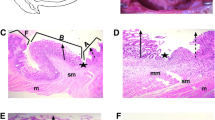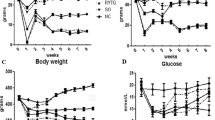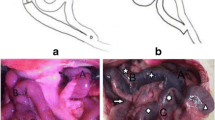Abstract
Background
To examine the effect and mechanism of Roux-en-Y gastric bypass (RYGB) on the improvement of diabetes according to the length of anastomosis and the gastric pouch volume in an animal model.
Methods
Glucose intolerance was induced with a high-fat diet for 3 months in Sprague–Dawley rats. The animals were subjected to conventional RYGB (cRYGB; 5% gastric pouch with 15-cm Roux limb, 40-cm biliopancreatic limb; n = 9), short-limb RYGB (sRYGB; 5%, 8, 4 cm; n = 9), fundus-sparing RYGB (fRYGB; 30%, 8, 4 cm; n = 9), or sham operation (n = 9). After 6 weeks, oral glucose tolerance tests (OGTTs) were performed, and gut hormones including insulin, total GLP-1, GIP, and ghrelin were analyzed.
Results
The cRYGB group showed significantly decreased food intake, body weight, and random glucose (p < 0.05). sRYGB resulted in a similar change of body weight loss to that of cRYGB, but with no improvement of hyperglycemia. The fRYGB group showed similar changes of body weight and random glucose to those of the sham group. In cRYGB and sRYGB, the level of insulin steeply increased until 30 min during OGTT. GLP-1 was higher at 30 min in cRYGB than in other groups, without significance. The fRYGB group showed a slowly increasing pattern in OGTT and GLP-1, and the lowest peak point in insulin and GIP.
Conclusion
cRYGB with 95% gastric resection was needed to achieve not only weight loss but also diabetes improvement, which could be related to the increase in GLP-1.








Similar content being viewed by others
References
Zimmet P, Alberti KG, Shaw J (2001) Global and societal implications of the diabetes epidemic. Nature 414:782–787
Chen L, Magliano DJ, Zimmet PZ (2012) The worldwide epidemiology of type 2 diabetes mellitus—present and future perspectives. Nat Rev Endocrinol 8:228–236
The Statiscitcs Korea (2014) Annual report on the causes of death statistics
Buchwald H, Avidor Y, Braunwald E et al (2004) Bariatric surgery: a systematic review and meta-analysis. JAMA 292:1724–1737
Schauer PR, Kashyap SR, Wolski K et al (2012) Bariatric surgery versus intensive medical therapy in obese patients with diabetes. N Engl J Med 366:1567–1576
Mingrone G, Panunzi S, De Gaetano A et al (2012) Bariatric surgery versus conventional medical therapy for type 2 diabetes. N Engl J Med 366:1577–1585
Lee W, Ahn SH, Lee JH et al (2012) Comparative study of diabetes mellitus resolution according to reconstruction type after gastrectomy in gastric cancer patients with diabetes mellitus. Obes Surg 22:1238–1243
Cho YM (2013) Mechanism of weight loss and diabetes remission after bariatric/metabolic surgery. Korean J Med 84:629–639
Friedman MN, Sancetta AJ, Magovern GJ (1955) The amelioration of diabetes mellitus following subtotal gastrectomy. Surg Gynecol Obstet 100:201–204
Ho TW, Wu JM, Yang CY et al (2016) Total gastrectomy improves glucose metabolism on gastric cancer patients: a nationwide population-based study. Surg Obes Relat Dis 12:635–641
Xiong SW, Zhang DY, Liu XM et al (2014) Comparison of different gastric bypass procedures in gastric carcinoma patients with type 2 diabetes mellitus. World J Gastroenterol 20:18427–18431
Zhu Z, Shan X, Cheng Y et al (2015) Clinical course of diabetes after gastrectomy according to type of reconstruction in patients with concurrent gastric cancer and type 2 diabetes. Obes Surg 25:673–679
Lingvay I, Guth E, Islam A et al (2013) Rapid improvement in diabetes after gastric bypass surgery: is it the diet or surgery? Diabetes Care 36:2741–2747
Jackness C, Karmally W, Febres G et al (2013) Very low-calorie diet mimics the early beneficial effect of Roux-en-Y gastric bypass on insulin sensitivity and beta-cell function in type 2 diabetic patients. Diabetes 62:3027–3032
Pories WJ, Swanson MS, MacDonald KG et al (1995) Who would have thought it? An operation proves to be the most effective therapy for adult-onset diabetes mellitus. Ann Surg 222:339–350 (discussion 50–52)
Dixon JB, O’Brien PE, Playfair J et al (2008) Adjustable gastric banding and conventional therapy for type 2 diabetes: a randomized controlled trial. JAMA 299:316–323
Shin AC, Zheng H, Pistell PJ et al (2011) Roux-en-Y gastric bypass surgery changes food reward in rats. Int J Obes 35:642–651
Zheng HY, Shin AC, Lenard NR et al (2009) Meal patterns, satiety, and food choice in a rat model of Roux-en-Y gastric bypass surgery. Am J Physiol Reg I 297:R1273–R1282
Shin AC, Zheng HY, Townsend RL et al (2010) Meal-Induced hormone responses in a rat model of Roux-en-Y gastric bypass surgery. Endocrinology 151:1588–1597
Yang J, Li C, Liu H et al (2010) Effects of subtotal gastrectomy and Roux-en-Y gastrojejunostomy on the clinical outcome of type 2 diabetes mellitus. J Surg Res 164:e67–e71
Kim JW, Cheong JH, Hyung WJ et al (2012) Outcome after gastrectomy in gastric cancer patients with type 2 diabetes. World J Gastroenterol 18:49–54
Orci L, Chilcott M, Huber O (2011) Short versus long Roux-limb length in Roux-en-Y gastric bypass surgery for the treatment of morbid and super obesity: a systematic review of the literature. Obes Surg 21:797–804
Salameh BS, Khoukaz MT, Bell RL (2010) Metabolic and nutritional changes after bariatric surgery. Expert Rev Gastroenterol Hepatol 4:217–223
Kim WS, Kim JW, Ahn CW et al (2013) Resolution of type 2 diabetes after gastrectomy for gastric cancer with long limb Roux-en Y reconstruction: a prospective pilot study. J Korean Surg Soc 84:88–93
Cho YM, Fujita Y, Kieffer TJ (2014) Glucagon-like peptide-1: glucose homeostasis and beyond. Annu Rev Physiol 76:535–559
Seino Y, Fukushima M, Yabe D (2010) GIP and GLP-1, the two incretin hormones: similarities and differences. J Diabetes Investig 1:8–23
Cho YM, Kieffer TJ (2010) K-cells and glucose-dependent insulinotropic polypeptide in health and disease. Vitam Horm 84:111–150
Acknowledgements
This research was supported by grants from the Seoul National University Hospital (Grant No. 0420150340), JW-Pharmaceutical (Grant No. 0620130910), and the Korea Health Technology R&D Project through the Korea Health Industry Development Institute (KHIDI), funded by the Ministry of Health & Welfare, Republic of Korea (Grant No. H I14C1277).
Author information
Authors and Affiliations
Corresponding author
Ethics declarations
Conflict of interest
The authors declare that they have no competing interests.
Rights and permissions
About this article
Cite this article
Huh, YJ., Son, YG., Kim, TH. et al. Effect and Mechanisms of Diabetes Resolution According to the Range of Gastric Resection and the Length of Anastomosis in Animal Models: Implication for Gastric Cancer Surgery in Patients with Diabetes Mellitus. World J Surg 42, 1056–1064 (2018). https://doi.org/10.1007/s00268-017-4228-8
Published:
Issue Date:
DOI: https://doi.org/10.1007/s00268-017-4228-8




